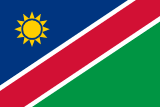Gender Quotas Database

Namibia
Southern Africa
Single / Lower House
National Assembly
| Total seats | 104 |
| Total women | 44 |
| Percentage of women | 42% |
| Gender Quota target | |
| Election year | 2024 |
| Electoral system | List PR |
| Quota type | |
| Election details | IDEA Voter Turnout - IPU Parline |
Upper House
Senate
| Total seats | 42 |
| Total women | 6 |
| Percentage of women | 14% |
| Gender Quota target | |
| Election year | 2020 |
| Electoral system | |
| Quota type | No legislated |
| Election details | IPU Parline |
| Legal source | Details | |
|---|---|---|
| No data available | ||
Quota at the Sub-National Level
| Quota type | Legislated Candidate Quotas |
| Gender Quota target | 40% |
| Legal source | Details | |
|---|---|---|
| Quota type: Legislated Candidate Quotas | Electoral law |
For the purposes of any election contemplated in subsection (2), each party list shall contain as candidates for such election - (a) in the case of a municipal council or town council consisting of 10 or fewer members or a village council, the names of at least three female persons; (b) in the case of a municipal council or town council consisting of 11 or more members, the names of at least five female persons. (Article 6.4) |
Voluntary Political Party Quotas*
| Party | Official Name | Details, Quota provisions |
|---|---|---|
| South West Africa People's Organisation | (SWAPO) |
SWAPO has a 50 percent quota with a zebra-system (alternation between men and women) for women on electoral lists for local elections. |
* Only political parties represented in parliament are included. When a country has legislated quotas in place, only political parties that have voluntary quotas that exceed the percentage/number of the national quota legislation are presented in this table.
Additional information
The first women's quota was established in the Local Authorities Act of 1992, which stipulated that in the elections of local authority councils with ten or fewer members, there had to be at least two women on party lists. On the lists of parties in elections to councils of eleven or more members, at least three had to be women. In 1997, these figures were increased to three and five, respectively, and in 2002 this rule was adopted as applicable to future elections (Frank 2004: 88; LeBeau and Dima 2005: 84).
In August 2013, the South West African People's Organisation (SWAPO), which is the ruling party in the National Assembly, adopted a 50 per cent gender quota which shall apply to all the national and regional structures of the party.
Sources
LEGAL SOURCES:
OTHER SOURCES:
- Parliament of Namibia - Link
- Electoral Commission - Link
- Frank, L. ‘Moving Towards Gender Balance in Elected Positions of Government in Namibia’, in J. Ballington (ed.), The Implementation of Quotas: African Experiences, Quota Report Series no. 3 (Stockholm: International IDEA, 2004)
- LeBeau, D. & Dima, E. Multiparty Democracy and Elections in Namibia, Electoral Institute for Sustainable Democracy in Africa (EISA) Research Report no. 13 (Auckland Park: EISA, 2005)
- O'Riordan, A. Namibia's 'zebra' politics could make it stand out from the global herd. The Guardian. 28 July 2014. Guardian News and Media Limited.
- Immanuel, S. ‘Swapo’s Pro-women Constitution Launched’, The Namibian, 28 August 2013.
Additional reading
- See the latest updates on Namibia on iKNOW Politics
- The Namibian, 2022, Mixed feelings on gender parity progress, Link to article
- O'Riordan, A. July 8, 2014. Guardian News and Media Limited. 'Namibia's 'zebra' politics could make it stand out from the global herd', http://www.theguardian.com/global-development/2014/jul/08/namibia-gender-equality-zebra-politics
- Bauer, G. 2004. ‘ “The Hand That Stirs the Pot Can Also Run the Country”: Electing More Women to Parliament in Namibia’, Journal of Modern African Studies, 42, 4: 479–509.
- Amupadhi, T. & Hamata, M. 2002. ‘President Forced to Drop Women's Quota’, The Namibian, August 27. http://afrol.com/News2002/nam011_women_quota.htm.
- Frank, L. 2001. ‘Where there is Political Will, there is a way’, Sister Namibia 13(5-6), p. 6.
- Hubbard, D. ‘50/50 Options for Namibia’, prepared by Legal Assistance Southern African Politics’ Centre for the Namibian Women’s Manifesto Network, June 2001.
- Yoon, M. Y. 2001. ‘Democratization and Women's Legislative Representation in Sub-Saharan Africa’, Democratization, 8(2), p.169-190.
- Becker, H. 2000. ‘Striving for change: The struggle for gender equality in Namibia’, in E. Iipinge and M. Williams (eds) Gender and Development, Windhoek: University of Namibia and UNDP, pp. 30–47.
- Frank, L. 2000a. ‘Achieving Gender Balance in Politics’, Sister Namibia, 12(3-4), pp. 7-9.
- Frank, L. 2000b. ’Namibia’, in Joana S. Foster & Stella T (eds) Women in Politics & Decision-Making: A Gendered Political Analysis. pp. 64-94.
- Kethusegile, B. et al. 2000. Beyond Inequalities: Women in Southern Africa. Harare: SARDC.
- Lowe-Morna, C. 2000. ‘Strategies for Increasing Women's Participation in Politics’, Paper presented to the Fifth Meeting of Commonwealth Ministers Responsible for Women's Affairs.
- Frank, L. 1999. ‘Women in Politics and Decision Making in Namibia’, Sister Namibia. 11. No. 2. p. 14.
- Reynolds, A. 1999. Women in African Legislatures and Executives: The Slow Climb to Power. Johannesburg: Electoral Institute of South Africa.
- Inter-Parliamentary Union. 1997. Democracy Still in the Making: A World Comparative Study. Geneva: Inter-Parliamentary Union.
Explore more resources: Africa | Global
Know about useful additional reading for Namibia? Tell us!
Submit feedback
Submit questions or comments about the Data or Tool
How did you find out about this? What do you like about it? What did you expect but did not find in using the Data or Tool?
To see how we handle your personal data, please read our Privacy Policy.
